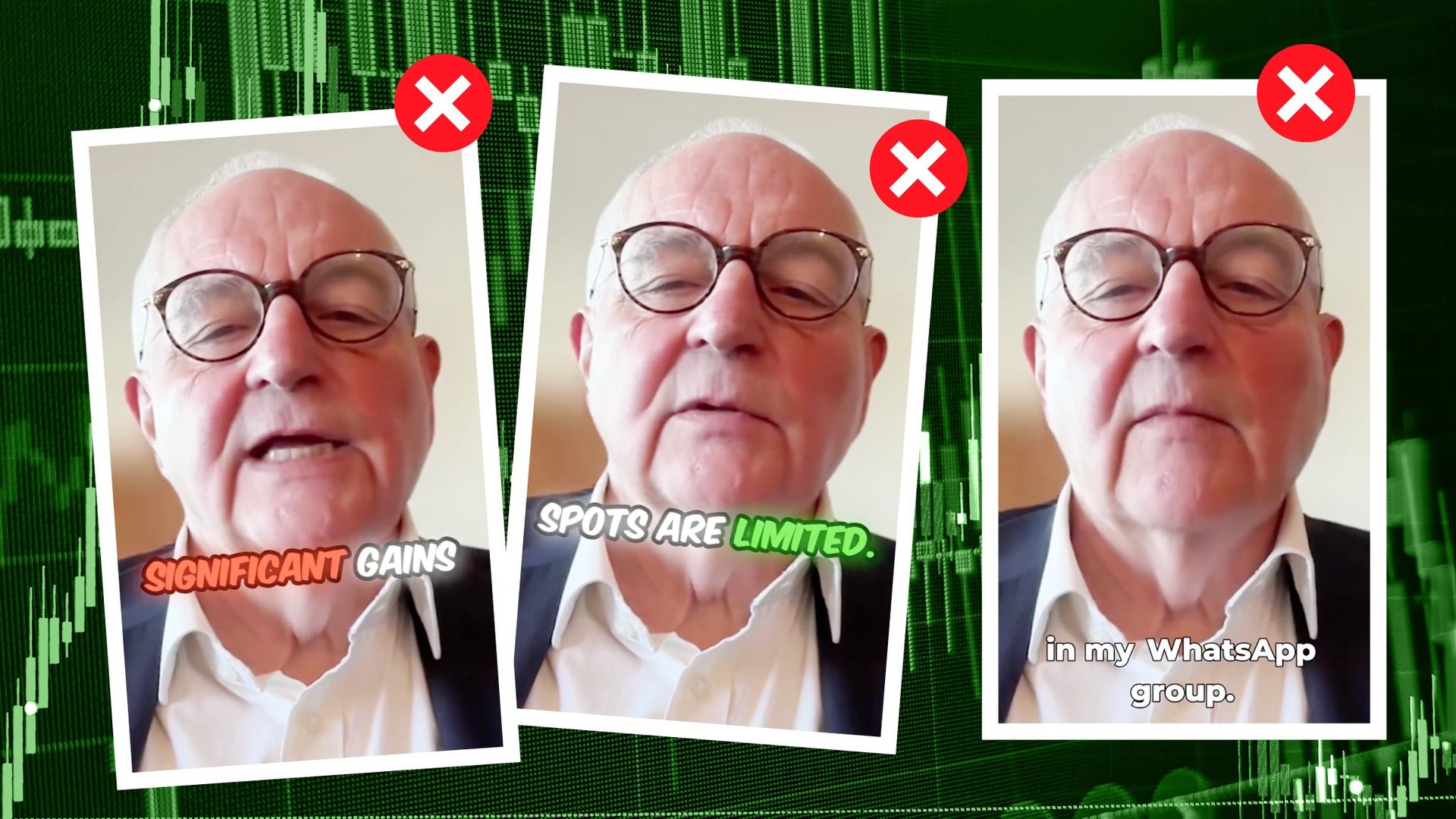尊敬的用户您好,这是来自FT中文网的温馨提示:如您对更多FT中文网的内容感兴趣,请在苹果应用商店或谷歌应用市场搜索“FT中文网”,下载FT中文网的官方应用。


I have an alter ego or, as it is now known on the internet, an avatar. My avatar looks like me and sounds at least a bit like me. He pops up constantly on Facebook and Instagram. Colleagues who understand social media far better than I do have tried to kill this avatar. But so far at least they have failed.
我有另一个自我,或者用现在网络上的说法,一个化身。我的化身看起来像我,说话也至少有点像我。他经常出现在Facebook和Instagram上。那些比我更懂社交媒体的同事曾试图“消灭”这个化身,但至少到目前为止,他们还没有成功。
Why are we so determined to terminate this plausible-seeming version of myself? Because he is a fraud — a “deepfake”. Worse, he is also literally a fraud: he tries to get people to join an investment group that I am allegedly leading. Somebody has designed him to cheat people, by exploiting new technology, my name and reputation and that of the FT. He must die. But can we get him killed?
为什么我们如此坚决要终结这个看似可信的‘我’的版本?因为他是个骗子——一个“深度伪造”。更糟糕的是,他还真的骗人:他试图让人们加入一个据称由我领导的投资团体。有人利用新技术、我的名字和声誉,以及英国《金融时报》的名气,设计了他来欺骗他人。他必须被消灭。但我们真的能让他消失吗?
I was first introduced to my avatar on March 11 2025. A former colleague brought his existence to my attention and I brought him at once to that of experts at the FT.
我第一次接触到我的虚拟分身是在2025年3月11日。一位前同事让我注意到他的存在,我随即将这件事告知了英国《金融时报》的专家。
It turned out that he was in an advertisement on Instagram for a WhatsApp group supposedly run by me. That means Meta, which owns both platforms, was indirectly making money from the fraud. This was a shock. Someone was running a financial fraud in my name. It was as bad that Meta was profiting from it.
结果发现,他是在Instagram上看到了一则广告,宣传一个据称由我运营的WhatsApp群组。这意味着拥有这两个平台的Meta实际上间接从这场诈骗中获利。这让我感到非常震惊。有人以我的名义进行金融诈骗。而同样糟糕的是,Meta也从中获利。
My expert colleague contacted Meta and after a little “to-ing and fro-ing”, managed to get the offending adverts taken down. Alas, that was far from the end of the affair. In subsequent weeks a number of other people, some whom I knew personally and others who knew who I am, brought further posts to my attention. On each occasion, after being notified, Meta told us that it had been taken down. Furthermore, I have also recently been enrolled in a new Meta system that uses facial recognition technology to identify and remove such scams.
我的专家同事联系了Meta,经过一番“来回沟通”,终于让那些违规广告被下架了。可惜,这件事远未就此结束。在接下来的几周里,又有一些人——有的是我认识的,有的是知道我是谁的人——向我反映了更多类似的帖子。每次我们举报后,Meta都会回复说相关内容已被删除。此外,最近我还被纳入了Meta的一项新系统,该系统利用人脸识别技术来识别并移除此类诈骗内容。
In all, we felt that we were getting on top of this evil. Yes, it had been a bit like “whack-a-mole”, but the number of molehills we were seeing seemed to be low and falling. This has since turned out to be wrong. After examining the relevant data, another expert colleague recently told me there were at least three different deepfake videos and multiple Photoshopped images running over 1,700 advertisements with slight variations across Facebook, and Instagram. The data, from Meta’s Ad Library, shows the ads reached over 970,000 users in the EU alone — where regulations require tech platforms to report such figures.
总的来说,我们觉得自己已经逐步掌控了这种恶行。确实,这有点像“打地鼠”,但我们看到的“地鼠洞”数量似乎很少,而且还在减少。然而,事实证明我们的判断是错误的。最近,在分析相关数据后,一位专家同事告诉我,至少有三段不同的深度伪造视频和多张经过Photoshop处理的图片,以细微差别在Facebook和Instagram上投放了超过1,700条广告。来自Meta广告资料库的数据表明,这些广告仅在欧盟地区就触达了超过97万用户——而欧盟的法规要求科技平台必须报告此类数据。
“Since the ads are all in English, this likely represents only part of their overall reach,” my colleague noted. Presumably many more UK accounts saw them as well.
“由于这些广告都是英文的,这很可能只反映了他们整体影响力的一部分,”我的同事指出。据推测,还有更多英国账户也看到了这些广告。
These ads were purchased by ten fake accounts, with new ones appearing after some were banned. This is like fighting the Hydra!
这些广告是由十个虚假账号购买的,一些账号被封后又有新的账号出现。这就像在和九头蛇作战!
That is not all. There is a painful difference, I find, between knowing that social media platforms are being used to defraud people and being made an unwitting part of such a scam myself. This has been quite a shock. So how, I wonder, is it possible that a company like Meta with its huge resources, including artificial intelligence tools, cannot identify and take down such frauds automatically, particularly when informed of their existence? Is it really that hard or are they not trying, as Sarah Wynn-Williams suggests in her excellent book Careless People?
这还不止于此。我发现,知道社交媒体平台被用来诈骗他人,和自己无意中卷入这类骗局之间,有着令人痛苦的差别。这让我大为震惊。那么,我不禁要问,像Meta这样拥有庞大资源和人工智能工具的公司,为什么不能在得知这些骗局存在后,自动识别并删除相关内容?这真的有那么难吗,还是正如萨拉•温-威廉姆斯(Sarah Wynn-Williams)在她那本出色的《粗心大意的人》(Careless People)中所说,他们根本没有尽力?
We have been in touch with officials at the Department for Culture, Media and Sport, who directed us towards Meta’s ad policies, which state that “ads must not promote products, services, schemes or offers using identified deceptive or misleading practices, including those meant to scam people out of money or personal information”. Similarly, the Online Safety Act requires platforms to protect users from fraud.
我们已与英国文化、媒体与体育部的官员取得联系,他们指引我们查阅Meta的广告政策。该政策规定:“广告不得推广使用已识别的欺骗性或误导性手段的产品、服务、方案或优惠,包括那些旨在骗取他人金钱或个人信息的行为。”同样,《在线安全法》(Online Safety Act)也要求平台保护用户免受欺诈行为的侵害。
A spokesperson for Meta itself said: “It’s against our policies to impersonate public figures and we have removed and disabled the ads, accounts, and pages that were shared with us.”
Meta公司的一位发言人表示:“冒充公众人物违反了我们的政策,我们已经删除并禁用了与我们共享的广告、账户和页面。”
Meta said in self-exculpation that “scammers are relentless and continuously evolve their tactics to try to evade detection, which is why we’re constantly developing new ways to make it harder for scammers to deceive others — including using facial recognition technology.” Yet I find it hard to believe that Meta, with its vast resources, could not do better. It should simply not be disseminating such frauds.
Meta为自己辩解称:“骗子锲而不舍,不断改进手法以规避检测,因此我们也在不断开发新方法,让骗子更难欺骗他人——包括使用人脸识别技术。”然而,我很难相信拥有如此庞大资源的Meta不能做得更好。它本就不该传播这些诈骗信息。
In the meantime, beware. I never offer investment advice. If you see such an advertisement, it is a scam. If you have been the victim of this scam, please share your experience with the FT at visual.investigations@ft.com. We need to get all the ads taken down and so to know whether Meta is getting on top of this problem.
与此同时,请务必保持警惕。我从不提供投资建议。如果你看到此类广告,那就是骗局。如果你曾是这类骗局的受害者,请将你的经历发送至英国《金融时报》的邮箱 visual.investigations@ft.com。我们需要让所有相关广告下架,并了解Meta是否正在有效应对这一问题。
Above all, this sort of fraud has to stop. If Meta cannot do it, who will?
最重要的是,这种欺诈行为必须被制止。如果Meta都做不到,还有谁能做到?